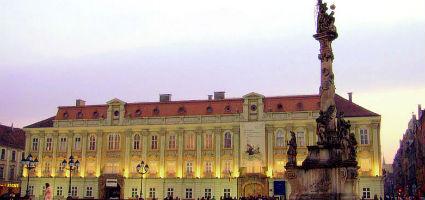2026. January 2. Friday
Temesvár Fine Art Museum - Timişoara
 |
Address: 300085, Timişoara P-ţa Unirii nr. 1
Phone number: (256) 491-592
E-mail: muzeuldeartatm@clicknet.ro
Opening hours: Tue-Sun 10-18
The "European Paintings" permanent exhibition is closed at the moment due to resurrection! |
Museum tickets, service costs:
|
Ticket for adults
|
5 HUF
|
|
|
Ticket for students
|
1 HUF
|
|
|
Ticket for pensioners
|
1 HUF
|
|
|
Photography
|
10 HUF
|
|
|
Video
|
20 HUF
|
The modern Romanian arts collection of our museum provides insight into the work of painters and sculptors, the development of schools and trends all over the country beginning in the 19th century. The collection includes masterpieces by "academists" from the 19th century (Sava Henţia, Constantin Lecca), as well as classic paintings by Theodor Aman, Nicolae Grigorescu and Ion Andreescu. The latter authors are also noteworthy for their ambition to open up for impressionist intentions acquiring bases of the Barbizon school.
Falling into line with modern expectations and inclination to follow Western-European models was traceable primarily in the art of Gheorghe Petraşcu, Theodor Pallady, Ştefan Popescu, Nicolae Tonitza, Ştefan Dimitrescu, Francisc Şirato, Iosif Iser and Ion Alexandru Steriadi. The artists listed did not only give a special interpretation to varied modernist ideals, "formulas" but also squared local traditions with light fauvism and by then harmless cubism.
The era and the collection of our museum related to these times can be characterised with variegation. The powerful artworks by Vasile Popescu, Michaela Eleutheriade, Camil Ressu, Ion Theodorescu-Sion, Rudolf Schweitzer-Cumpăna and Ion Ţuculescu are balanced by the light touch of Henri Catargi, Lucian Grigorescu, Catul Bogdan vagy Aurel Ciupe. Towards the middle of the 20th century, Alexandru Ciucurencu and Corneliu Baba joined the group opening up new perspectives. These three artists are considered the establishers of classic contemporary art In Romania
In Transylvania and in the Bánság Mişu Popp and Károly Szathmáry Papp (Carol Popp de Szathmáry), as well as Anselm Wagner, Karl Brocky, Filalla Antal, Sava Petrovič, Constantin Daniel, Adolf Humborg, Mihail Velceleanu, Nicolae Popescu and Ion Zaicu produced quality art with aesthetic value. In reality, they are the artists who determine the line of development that slowly diverges from Biedermeir portrait painting and gets closer to academic portraits and self-portraits. An illustrious representative of this temporary era is Ştefan Jäger.
He is followed by artists who mostly educated in Budapest, Vienna, Munich and Rome. The even younger generation studied in Kolozsvár, and at the Collage of Temesvár established in 1933. They are students of Catul Bogdan, Aurel Ciupé, Anastase Demian and Romul Ladeá, former representatives of Romanian art.
During the period between WWI and WWII, art scene in the Bánság changes enormously. On one hand Gyula Podlipnyi's dramatic graphics, Ferdinánd Gallas's hedonist statues, Franz Ferch and Albert Varga's exciting painting rule the scene. On the other hand, Catul Bogdan and Aurel Ciupe's warm landscapes, Anastase Demian's ornaments never failing to provide thoughts, as well as the expressionist Romul Ladea who feeds on forms of Rodin and Brâncuşi. Our visitors are invited to dissolve these contradictions inside. The set up of the showing provides visual help in this endeavour.
Falling into line with modern expectations and inclination to follow Western-European models was traceable primarily in the art of Gheorghe Petraşcu, Theodor Pallady, Ştefan Popescu, Nicolae Tonitza, Ştefan Dimitrescu, Francisc Şirato, Iosif Iser and Ion Alexandru Steriadi. The artists listed did not only give a special interpretation to varied modernist ideals, "formulas" but also squared local traditions with light fauvism and by then harmless cubism.
The era and the collection of our museum related to these times can be characterised with variegation. The powerful artworks by Vasile Popescu, Michaela Eleutheriade, Camil Ressu, Ion Theodorescu-Sion, Rudolf Schweitzer-Cumpăna and Ion Ţuculescu are balanced by the light touch of Henri Catargi, Lucian Grigorescu, Catul Bogdan vagy Aurel Ciupe. Towards the middle of the 20th century, Alexandru Ciucurencu and Corneliu Baba joined the group opening up new perspectives. These three artists are considered the establishers of classic contemporary art In Romania
In Transylvania and in the Bánság Mişu Popp and Károly Szathmáry Papp (Carol Popp de Szathmáry), as well as Anselm Wagner, Karl Brocky, Filalla Antal, Sava Petrovič, Constantin Daniel, Adolf Humborg, Mihail Velceleanu, Nicolae Popescu and Ion Zaicu produced quality art with aesthetic value. In reality, they are the artists who determine the line of development that slowly diverges from Biedermeir portrait painting and gets closer to academic portraits and self-portraits. An illustrious representative of this temporary era is Ştefan Jäger.
He is followed by artists who mostly educated in Budapest, Vienna, Munich and Rome. The even younger generation studied in Kolozsvár, and at the Collage of Temesvár established in 1933. They are students of Catul Bogdan, Aurel Ciupé, Anastase Demian and Romul Ladeá, former representatives of Romanian art.
During the period between WWI and WWII, art scene in the Bánság changes enormously. On one hand Gyula Podlipnyi's dramatic graphics, Ferdinánd Gallas's hedonist statues, Franz Ferch and Albert Varga's exciting painting rule the scene. On the other hand, Catul Bogdan and Aurel Ciupe's warm landscapes, Anastase Demian's ornaments never failing to provide thoughts, as well as the expressionist Romul Ladea who feeds on forms of Rodin and Brâncuşi. Our visitors are invited to dissolve these contradictions inside. The set up of the showing provides visual help in this endeavour.